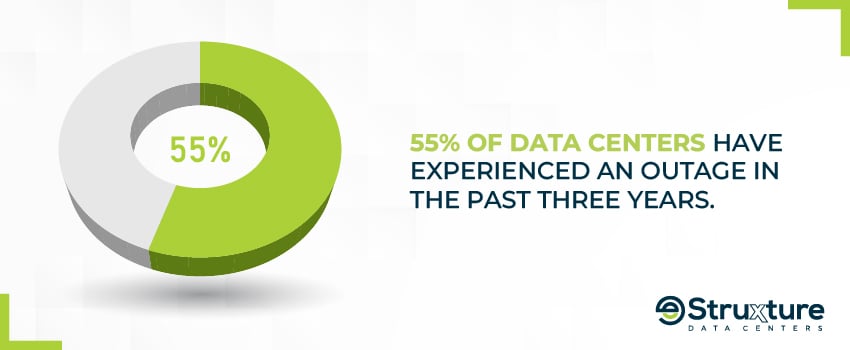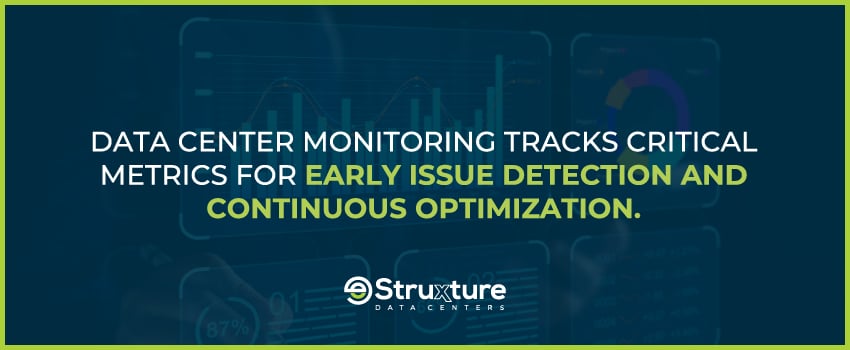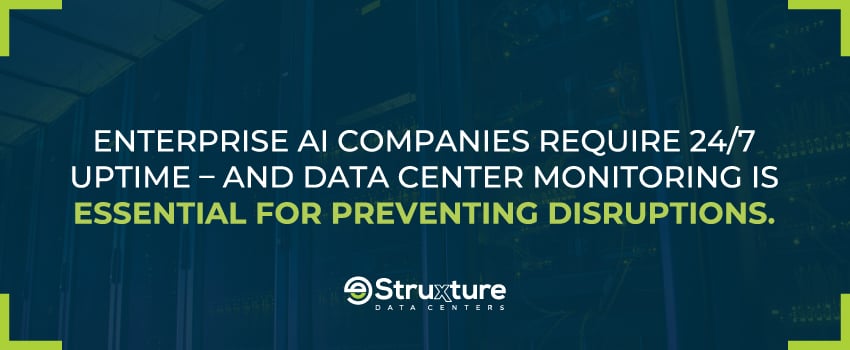Data centers are the backbone of business infrastructure, hosting mission-critical applications, services, and data. Enterprise AI companies and other businesses require always-on connectivity – and data centers need to ensure 24/7 network availability and optimal performance.
Unfortunately, over half (55%) of data centers experienced an outage in the past three years.1 And with 66% of all data center outages costing businesses more than $100,000,2 downtime simply isn't an option. As a result, more data center providers are turning to data center monitoring tools to help solve issues that impact network performance and disrupt operations.
In this blog, we'll explain how data center monitoring assists providers in keeping their facilities operating at peak performance – so businesses can stay connected.
What Is Data Center Monitoring?
Data center monitoring is a process used by data center operators to continuously track, visualize, analyze, and manage infrastructure performance metrics in real time. With monitoring tools, data center staff gain end-to-end visibility and actionable insights with data from servers, network devices, power systems, and environment sensors across the entire data center. This data enables data center providers to optimize capacity, quickly react to unplanned downtime, and ensure their platform can meet customers' business requirements.
How Does Data Center Monitoring Work?
Data center monitoring tools use environmental sensors and specialized protocols to capture health statistics across all network infrastructure layers, from ambient cooling equipment and power systems to individual IT assets. Primary components include:
Software Platform
Data center monitoring software provides a central interface to aggregate historical data, apply analytics, and present actionable dashboards, mapping, reports, and alerts. Advanced systems can automate responses to security and performance issues using workflow engines and Representational State Transfer Application Programming Interfaces (REST APIs). Integration with popular DevOps tools is also commonly available to consolidate data center infrastructure visibility.
Infrastructure Sensors
Environmental sensors throughout the facility feed into the data center monitoring system to track conditions like temperature, humidity, leak detection, door access control, and vibration. This allows staff to identify data center issues early, including hot spots, cooling failures, and unusual vibrations that could indicate imminent hardware failures. Sensors are available in flexible form factors to mount within racks, under raised floors, above drop ceilings, and on walls.
IT Infrastructure Agents
Software agents are installed on servers, network devices, and storage systems to communicate granular performance, utilization, and configuration data. Agents connect using protocols like Simple Network Management Protocol (SNMP), Redfish, and Intelligent Platform Management Interface (IPMI) to poll hardware health statistics while operating system agents provide insight into virtual machines, applications, logs, and software-defined infrastructure. Together, these agents provide comprehensive visibility of individual IT assets across thousands of devices.
Unified Dashboards
Data center monitoring tools correlate all data sources into unified dashboards that combine environmental facility health, power system capacity, network topology visualization, and IT infrastructure status. This enables operators to quickly assess the overall health of their data centers and drill down to find the root causes of issues across equipment domains.

What Should Data Centers Monitor?
While data center monitoring solutions are highly customizable to each environment, most organizations focus attention on the following key areas:
Switches and Routers
Tracking key performance indicators for network infrastructure is critical for ensuring high availability and optimized application delivery across the data center ecosystem.
- Port Utilization - Monitoring port utilization ensures that network capacity can keep pace with traffic growth as demand increases.
- Packet Loss and Latency - Tracking packet loss and latency metrics helps identify network connectivity issues that may impact application performance and user experience.
- Bandwidth Consumption - Evaluating bandwidth consumption against allocation provides insight into use versus planned capacity across inter-switch links to prevent bottlenecks.
- Per-Port Utilization - Enabling per-port utilization statistics at a granular level simplifies troubleshooting by pinpointing which interfaces may be overloaded during a degradation event.
- Traffic Mapping - Generating traffic mapping provides graphical visualization correlating how application flows map across the physical network infrastructure for efficient troubleshooting.
Critical Server KPIs
Server health metrics help administrators optimize virtual machine density and right-size instances, establish performance baselines, and ensure the data center infrastructure adheres to service level agreements (SLAs).
- CPU/Memory Usage - Tracking CPU and memory usage facilitates virtual machine density optimization while appropriately provisioning resources to prevent oversubscription and refresh hardware that no longer meets capacity needs.
- Processor Queue Length - Monitoring processor queue length provides an early indicator for potential bottlenecks that may threaten application performance objectives.
- Paging File Usage - Evaluating paging file usage signals that Windows-based platforms are experiencing memory pressures that may degrade stability if left unchecked.
- Disk I/O Response Time - Recording disk I/O (input/output) response time provides a critical metric that directly impacts application stability based on fluctuations from baseline expectations.
- Network Interface Throughput - Reporting on network interface throughput helps ensure there is adequate platform network capacity aligned to application network dependence and usage profiles.
Power and Hardware Metrics
Holistic power chain monitoring combined with granular tracking of racks, servers, and infrastructure systems minimizes equipment failure while maximizing power utilization across critical components.
- Power Capacity - Tracking power capacity at all levels, from utility feeds to rack power strips, helps operators ensure balanced and redundant delivery for system protection and high availability.
- Voltage/Current Fluctuations - Detecting voltage and current fluctuations prevents damage to hardware, such as servers and storage systems, by signaling deviations from safe operating tolerances.
- Thermal Load Output - Monitoring thermal load output helps optimize deployment density and cooling system efficiency by balancing heat generation across facility zones.
- PDU Power Strips - Reporting utilization down to rack PDU (power distribution unit) power strip and outlet level facilitates load balancing to prevent oversubscription of the available power budget.
- Asset Inventory - Automating asset inventory tracking ensures servers and critical infrastructure are accurately accounted for across the data center infrastructure.
- Utilization Reporting - Generating resource utilization reporting enables the right-sizing of deployments across all environments to eliminate stranded capacity and prevent gaps.

What Are the Benefits of Data Center Monitoring?
Comprehensive data center monitoring tools deliver several advantages to help data center staff ensure their customers stay connected, including:
Increased Visibility
By correlating real-time data and metrics across siloed monitoring tools, data center employees gain a unified view of all components within the ecosystem. With this end-to-end visibility, staff can identify and resolve issues faster and make strategic decisions for capacity planning.
Greater Availability
A data center monitoring tool enables administrators to customize thresholds and alerts for temperature, humidity, and power utilization. Data center staff are notified about impending issues as early as possible. This kind of maintenance is critical for providing effective solutions to disruptive downtime events.
Optimized Infrastructure
With detailed tracking and reporting of CPU (central processing unit), memory, and storage utilization, data center providers can identify overprovisioned resources to reduce operating costs or capacity gaps to prevent future shortfalls. With this intelligence, management can better align infrastructure investments with network demands.
Enhanced Security
Data center monitoring is also pivotal in tracking facility access and user activity for physical security and compliance auditing purposes. Detailed system logs enable forensics analysis while proving due diligence to regulators.
Who Should Use a Data Center Monitoring Tool?
Given the central role modern data centers play in daily operations, any business that relies on colocation facilities or manages internal server rooms should implement data center monitoring. However, the following roles tend to benefit most from the holistic visibility and analytics a data center monitoring tool provides:
Data Center Managers and Operators
The day-to-day administration and upkeep of data centers depend on monitoring environmental conditions, tracking power utilization, and securing physical systems – all of which data center monitoring tools can streamline. Generating automated utilization reports can also aid data center operators in strategic planning for future growth and infrastructure lifecycle management.
Application and System Owners
Though not directly responsible for operating data centers, application developers rely on monitoring alerts to detect platform issues threatening SLAs. Server and network monitoring can help developers continuously tune environments to meet optimum performance levels as usage fluctuates.
Network Teams
Reporting on utilization rates, uptime metrics, and redundancy planning helps network teams allocate appropriate capital investments in power and cooling infrastructure required to maintain uptime as demand increases. Data center monitoring also validates the capacity needed for disaster recovery and availability across distributed facilities.
Auditors and Compliance Teams
Demonstrating due diligence around environmental safeguards, access controls, redundancy planning, and change management procedures depends on monitoring and reporting tools tracking all facets of data center operations – especially when periodic audits dictate security and uptime certifications.

Leverage Data Center Monitoring With eStruxture's Data Center Platform
Enterprise AI companies and other businesses can't afford disruptions to their data center environment that jeopardize operations. Data center monitoring solutions deliver the actionable insights providers need to keep their business clients' mission-critical applications available and customers connected.
With over 15 carrier-neutral facilities across Canada's major metro markets, eStruxture offers businesses reliable, scalable data center and colocation services. We leverage comprehensive data center monitoring to track and analyze infrastructure metrics in real time, so you can trust us to support even the most sophisticated workloads. Our customized approach means you'll always get the most efficient combination of space, power, cooling, and connectivity your business needs to grow. Get in touch today to learn more.
Sources:
